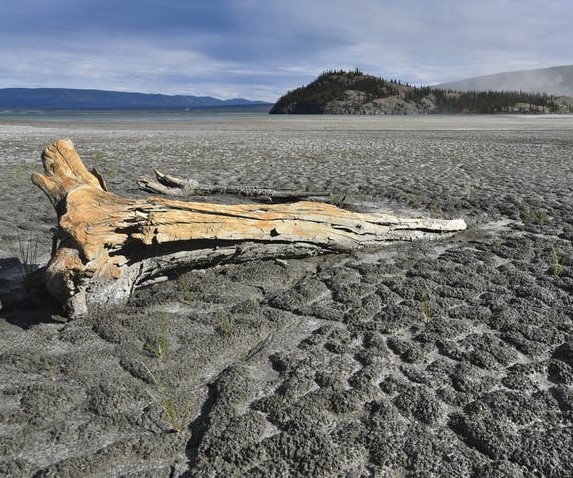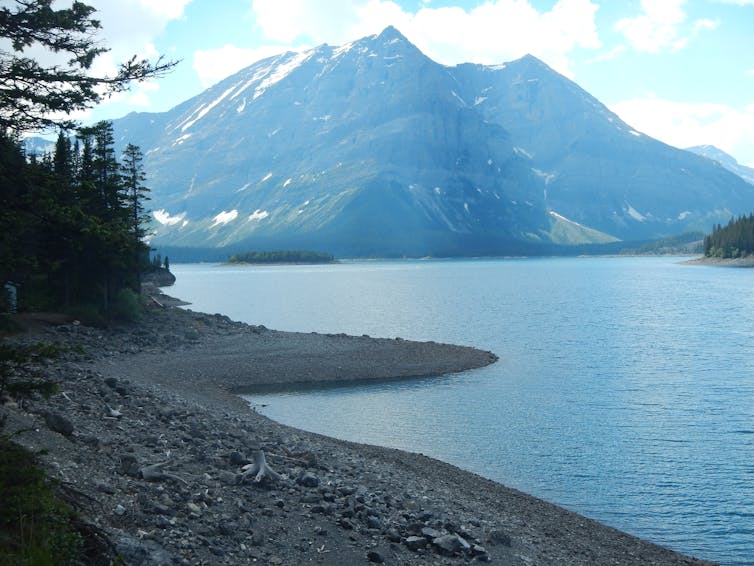How Canada can solve its emerging water crisis

The dry Kluane Lake in Yukon Territory. (Shutterstock) John Pomeroy, University of Saskatchewan; Chris DeBeer, University of Saskatchewan; Phani Adapa, University of Saskatchewan, and Stephanie Merrill, University of Saskatchewan
Canadians can no longer be assured that our waters are abundant, safe and secure. As global temperatures continue to increase, our glaciers melt, permafrost thaws, river flows become unpredictable and lakes warm and fill with toxic algae.
The science is telling us that water is moving through the water cycle at an accelerating pace, fundamentally changing weather and precipitation patterns.
Evidence of such change in Canada is mounting, with more frequent and extreme damage from floods, droughts and wildfires. A changing climate and a disrupted hydrological cycle also amplify the negative effects of development and pollution on river basins and are damaging aquatic life in our waterways from coast to coast to coast.
Skyrocketing costs
The impacts of these rapid changes on water availability and quality are costly. They undermine ecosystem health and the function of world-class parks and protected areas, traditional and subsistence ways of life, built infrastructure and food and energy production.
The quality of drinking water supplies in rural and Indigenous communities has become massively degraded in recent decades leading to more than 100 drinking water advisories for reserves in Canada as of 2015, forcing some First Nations reserves to boil water, pay for water delivery or haul it from a water filling station.
Read more: Collaboration can help in the Indigenous water crisis
Concern and conflicts over water are central to the public’s resistance and lack of trust around resource developments with significant economic and social consequences such as the Trans Mountain pipeline expansion.
Meanwhile, the cost of floods and droughts for families, towns and cities, the insurance sector, businesses and ultimately the federal government are skyrocketing and unsustainable.
The federal budget
The federal government has raised the issue of water in its recent budget with interest in two primary areas: drinking water in Indigenous communities and the impacts of climate change on Prairie water resources.
The federal government earmarked an additional $739 million in the budget to eliminate drinking-water advisories on reserves. Since 2015, the federal government has spent $2 billion to improve access to safe, clean drinking water in First Nations communities. As of March 2019, it has lifted 81 long-term drinking water advisories, leaving 59 advisories in place. It plans to have all long-term drinking water advisories removed by 2021.
This laudable goal is addressing the symptoms, but not the core water problems for Indigenous communities. Indigenous peoples’ inherent water rights, laws and jurisdictions, in addition to their negotiated treaties, land claims and governance agreements, indicate their role as full partners in water and land use decision-making.
But this has yet to be realized. Tangible action requires co-design of consistent, comprehensive plans and protections for waters that flow through their communities and traditional territories.
Upper Kananaskis Lake in the Canadian Rockies during the dry summer of 2018. John W. Pomeroy, Author provided
The federal budget also committed $1 million to develop a strategy to address the pressures on Prairie water resources which threaten farmers and ranchers. The Prairies have suffered from debilitating drought, flood and water quality degradation. How this strategy will incorporate the concerns, interests and rights of First Nations in the region remains to be fully addressed.
Read more: The global race for groundwater speeds up to feed agriculture's growing needs
These investments in water would be more effective if they were integrated into a federal freshwater agenda that co-ordinated its design and delivery with the provinces, territories and Indigenous peoples.
It could draw on the culture of private and public sector innovation and the existing base of western and Indigenous knowledge to develop robust solutions that position Canada as a leader for water solutions on the global stage.
The path to solutions
Most water management decisions are made locally through provincial and Indigenous jurisdictions. Yet the majority of our major river and lake basins straddle boundaries and cut across jurisdictional boundaries, rights and responsibilities, requiring the involvement of multiple provinces and Indigenous communities — and sometimes the United States.
The federal government can play an important role in four key areas:
-
Create a Canada Water Security Centre that measures, researches, predicts, stores and disseminates comprehensive information about surface water, groundwater, snow and glacier flows, storage and quality, and helps communities, industry and governments anticipate and respond to water problems, including flood, drought and water pollution forecasting and prediction.
-
Create a National Water Commission that strengthens transboundary water management, prioritizes the protection of healthy, intact river basins and lakes, and guides water management and water-related climate mitigation and adaptation strategies.
-
Strengthen reconciliation with Indigenous peoples by ensuring the Canada Water Act is consistent with the United Nations Declaration on the Rights of Indigenous Peoples and adopting a consent-based, co-drafting approach to renewing the act in partnership with Indigenous governments.
-
Improve collaborative river basin planning by building durable partnerships for water management and decision-making with provinces, territories and Indigenous governments, with a clear outcome of building resilience to extreme events, identifying priority areas for river basin restoration and ensuring ecosystem needs are addressed across levels of jurisdiction and authority.
Enabling these water solutions could save Canada billions of dollars by preventing damage to infrastructure and ecosystems, and reducing disaster payments. The federal government can carefully target existing expenditures, and financially support changes to a modernized Canada Water Act.
Read more: Understanding the risks to Canada’s drinking water
It is no longer desirable — or even possible — to maintain the status quo in terms of water management and governance in Canada. Our country’s water resources are changing rapidly, fuelled by a changing climate, altered hydrology and fragmented water decision-making across shared river basins and jurisdictions.
The emerging water crisis is affecting Canadians’ safety in face of extreme events and undermining the public’s trust in government’s ability to protect homes and properties from floods and fires, provide adequate food in times of drought, provide safe water for drinking and ensure clean waterways for fishing and swimming.
But the federal government can make the places we live more resilient and less vulnerable to climate change. And it can put Canada on the global stage by showing the world how to build lasting water security in an increasingly uncertain world.
The authors acknowledge the contributions of Tony Maas, Ralph Pentland, Michael Miltenberger, Merrell-Ann Phare, Oliver Brandes, Natasha Overduin and Robert Sandford, who are part of the Canada Water Security Initiative.
![]()
John Pomeroy, Distinguished Professor and Director, Global Water Futures Programme, University of Saskatchewan; Chris DeBeer, Science Manager, Global Water Futures, University of Saskatchewan; Phani Adapa, Assistant Director, University of Saskatchewan, and Stephanie Merrill, Research Scientist, Knowledge Mobilization, Global Insitute for Water Security, Global Water Futures Program, University of Saskatchewan
This article is republished from The Conversation under a Creative Commons license. Read the original article.
"Voices of the RSC” is a series of written interventions from Members of the Royal Society of Canada. The articles provide timely looks at matters of importance to Canadians, expressed by the emerging generation of Canada’s academic leadership. Opinions presented are those of the author(s), and do not necessarily reflect the views of the Royal Society of Canada.



